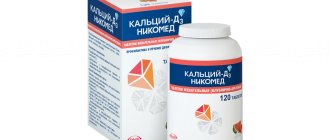Ektalust chewable tablets 4 mg 14 pcs.
Ectalust can be prescribed together with other drugs traditionally used for the prevention and long-term treatment of bronchial asthma. The recommended clinical dose of montelukast did not have a clinically significant effect on the pharmacokinetics of the following drugs: theophylline, prednisone, prednisone, oral contraceptives (ethinyl estradiol/norethindrone 35/1), terfenadine, digoxin and warfarin. AUC is reduced in individuals concomitantly receiving phenobarbital (by approximately 40%). However, such patients do not need to adjust the dosage regimen of Ektalust. Since montelukast is metabolized by the CYP3A4 isoenzyme, caution should be exercised, especially in children, when co-administering montelukast with drugs that induce the CYP3A4 isoenzyme, such as phenytoin, phenobarbital and rifampicin. In vitro studies have shown that montelukast is a potential inhibitor of the CYP2C8 isoenzyme, however, data from clinical drug-drug interaction studies involving montelukast and rosiglitazone (a pre-substrate of medicinal products primarily metabolized by the CYP2C8 isoenzyme) showed that doses of montelukast do not inhibit the CYP2C8 isoenzyme in vivo . Therefore, montelukast does not have a significant effect on the metabolism of drugs metabolized by this enzyme (for example, paclitaxel, rosiglitazone and repaglinide). When taking high doses of montelukast (at 20 and 60 times the recommended dose for adults), a decrease in plasma theophylline concentrations is observed. This effect is not observed when taking the drug in recommended doses - 10 mg per day. Bronchodilators: Ectalust can be added to the treatment of patients whose asthma is not controlled by bronchodilators alone. When a therapeutic effect is achieved (usually after the first dose) during therapy with Ektalust, the dose of bronchodilators can be gradually reduced. Inhaled glucocorticosteroids: Treatment with Ektalust provides an additional therapeutic effect to patients receiving treatment with inhaled glucocorticosteroids. Once the patient's condition has stabilized, the dose of glucocorticosteroids may be reduced. The dose of glucocorticosteroids should be reduced gradually, under the supervision of a physician. In some patients, inhaled glucocorticosteroids may be completely discontinued. It is not recommended to abruptly replace therapy with inhaled glucocorticosteroids by prescribing Ektalust.
Ektalust
Ektalust tablet chew 4 mg x14 ATX code: R03DC03 (Montelukast) Active substance: montelukast (montelukast) Rec.INN registered by WHO
Dosage form
EKTHALUST®
tab. chewable 4 mg: 7, 14, 20, 21, 28 or 30 pcs.reg. No.: LP-002248 dated 09/25/13 - Valid
Release form, composition and packaging
Chewable tablets are round, biconvex, white or almost white.
1 tab.
montelukast sodium 4.16 mg,
which corresponds to the content of montelukast 4 mg
Excipients: dextrates - 80 mg, mannitol - 69.44 mg, prosolv (microcrystalline cellulose 98%, colloidal silicon dioxide 2%) - 80 mg, strawberry flavor - 3.2 mg, aspartame - 0.8 mg, magnesium stearate - 2.4 mg.
Clinical and pharmacological group: Leukotriene receptor antagonist. A drug for the treatment of bronchial asthma and allergic rhinitis. Pharmacotherapeutic group: Leukotriene receptor antagonist
Indications
- long-term treatment and prevention of bronchial asthma, including prevention of daytime and nighttime symptoms of the disease,
- treatment of “aspirin” asthma,
- prevention of bronchospasm caused by physical activity,
— relief of daytime and nighttime symptoms of persistent and seasonal allergic rhinitis.
ICD-10 codes
ICD-10 code Indication
J30.1 Allergic rhinitis caused by pollen
J30.3 Other allergic rhinitis (perennial allergic rhinitis)
J45 Asthma
Dosage regimen
Ectalust® is taken orally, the tablet should be chewed 1 hour before meals or 2 hours after meals, 1 time/day. For the treatment of bronchial asthma, the drug should be taken in the evening. When treating allergic rhinitis, the drug can be taken at any time of the day at the request of the patient.
Adults 15 years of age and older are recommended to use other dosage forms of montelukast (eg, 10 mg film-coated tablets).
Children from 2 to 5 years: 1 chewable tablet at a dose of 4 mg 1 time/day, before bedtime. No dosage adjustment is required for this age group.
For children from 6 to 14 years old: 1 chewable tablet at a dose of 5 mg 1 time/day, before bedtime. No dosage adjustment is required for this age group.
General recommendations
The therapeutic effect of the drug Ektalust® on symptoms reflecting the course of bronchial asthma manifests itself during the first day. The patient should continue taking Ektalust® both during the period of controlled bronchial asthma and during the period of exacerbation of the disease.
For elderly patients, patients with renal failure, patients with mild and/or moderate liver dysfunction, no dose adjustment is required.
Prescribing Ektalust simultaneously with other types of asthma treatment
Ektalust® can be added to the patient’s treatment with bronchodilators and inhaled corticosteroids (see section “Interaction with other drugs”).
Side effect
In general, Ektalust® was well tolerated. Side effects are usually mild and usually do not require discontinuation of treatment. Overall incidence of adverse events reported with montelukast. comparable to that for placebo:.
Blood and lymphatic system disorders: increased tendency to bleeding.
Immune system disorders: hypersensitivity reactions, incl. anaphylaxis, eosinophilic infiltration of the liver (very rare - 0.01%).
Mental disorders: agitation, incl. aggressive behavior or hostility, anxiety, depression, disorientation, pathological dreams, hallucinations, insomnia, irritability, restlessness, somnambulism, suicidal thoughts and behavior (suicidality). tremor.
Nervous system disorders: headache, dizziness, drowsiness, paresthesia/hypesthesia, hyperkinesia, convulsions (very rare - <0.01%).
Cardiac disorders: palpitations.
Disorders of the respiratory system, chest and mediastinal organs: nosebleeds, upper respiratory tract infections, pharyngitis, cough, sinusitis, rhinorrhea.
Hearing disorders and labyrinthine disorders: otitis media (including medial).
Gastrointestinal disorders: diarrhea, dyspepsia, nausea, vomiting, pancreatitis, abdominal pain, dry mouth.
Disorders of the liver and biliary tract: increased activity of liver transaminases in the blood ALT, AST, hepatitis (including cholestatic, hepatocellular and mixed liver lesions) (very rare - <0.01%).
Skin and subcutaneous tissue disorders: angioedema, tendency to form hematomas, erythema nodosum, erythema multiforme, itching, rash, urticaria.
Musculoskeletal and connective tissue disorders: arthralgia, myalgia, including muscle spasms.
General disorders and disorders at the injection site: asthenia (weakness)/fatigue, edema, pyrexia, thirst. In rare cases, patients with bronchial asthma develop Churg-Strauss syndrome.
Contraindications for use
- hypersensitivity to any of the components of the drug,
- phenylketonuria,
- children under 2 years of age (for a dosage of 4 mg),
- children under 6 years of age (for a dosage of 5 mg).
Conditions for dispensing from pharmacies The drug is dispensed with a prescription.
Ectalust tablet film 10 mg x14
Trade name: Ektalust
International name: Montelukast&, (Montelukast)
Pharmacological group: anti-inflammatory antibronchoconstrictor agent - leukotriene receptor blocker
Pharmacological group for ATC: R03DC03. Montelukast
Compound:
Each 4 mg chewable tablet contains:
Active substance: montelukast - 4.00 mg (as montelukast sodium - 4.16 mg).
Excipients: mannitol - 192.38 mg (Pearlitol 300 DC - 75%, Parteck 100 M - 25%), Avicel CE-15 (microcrystalline cellulose - 85%, guar gum - 15%) - 21.38 mg, croscarmellose sodium - 9.6 mg, hyprolose (low-substituted) - 7.2 mg, cherry flavor - 0.24 mg, red iron oxide dye - 0.24 mg, magnesium stearate - 4.8 mg.
Each 5 mg chewable tablet contains:
Active substance: montelukast - 5.00 mg (as montelukast sodium 5.20 mg).
Excipients: mannitol - 240.475 mg (Pearlitol 300 DC - 75%, Parteck 100 M - 25%), Avicel CE-15 (microcrystalline cellulose - 85%, guar gum - 15%) - 26.725 mg, croscarmellose sodium - 12.00 mg, hyprolose (low-substituted) - 9.0 mg, cherry flavor - 0.3 mg, red iron oxide dye - 0.3 mg, magnesium stearate - 6.0 mg.
Film-coated tablets
Composition per 1 tablet:
tablet core:
active substance: montelukast sodium - 10.40 mg (corresponding to montelukast - 10.00 mg),
excipients: lactose monohydrate 89.10 mg, hyprolose type EF 4.00 mg, microcrystalline cellulose 89.00 mg, croscarmellose sodium 6.00 mg, - magnesium stearate 1.50 mg,
tablet shell: opadry beige ~5.00 mg.
Composition of opdra beige: hypromellose 3.13 mg, titanium dioxide 1.52 mg, macrogol-400 0.31 mg, iron (III) oxide yellow 0.04 mg, iron (III) oxide red dye 3 μg.
Description:
4 mg tablets: pink oval tablets with numerous darker inclusions, marked “4” on one side, with a cherry flavor.
5 mg tablets: round tablets of pink color with numerous darker inclusions, marked “5” on one side, with a cherry odor.
Film-coated tablets:
Rectangular in shape with rounded sides, biconvex, beige film-coated tablets, p. marked "10" on one side.
Fracture appearance: homogeneous white mass.
Pharmacodynamics:
Leukotriene receptor antagonist. Montelukast inhibits cysteinyl leukotriene receptors on the airway epithelium, while simultaneously exhibiting the ability to inhibit bronchospasm caused by inhaled cysteinyl leukotriene LTD4 in patients with bronchial asthma. A dose of 5 mg is sufficient to relieve bronchospasm induced by LTD4. The use of montelukast in doses exceeding 10 mg once a day does not increase the effectiveness of the drug.
Montelukast causes bronchodilation within 2 hours after oral administration and may be additive to the bronchodilation caused by beta2-agonists.
The bronchodilator effect develops within 1 day and persists for a long time.
Pharmacokinetics:
Suction:
After oral administration, montelukast is rapidly absorbed. Eating regular food does not affect Cmax in blood plasma and the bioavailability of the drug. Cmax in adults after taking a 5 mg chewable tablet on an empty stomach was achieved within two hours. The average oral bioavailability was 73%. Cmax after administration of a 4 mg chewable tablet on an empty stomach by children aged 2 to 5 years was achieved after two hours.
Distribution:
Montelukast is more than 99% bound to plasma proteins. The volume of distribution in a state of stable equilibrium averages 8-11 liters.
Metabolism: Montelukast is actively metabolized in the liver. When used in therapeutic doses, the concentration of montelukast metabolites in plasma at steady state in adults and children is not determined.
It is assumed that cytochrome P450 isoenzymes (ZA4 and 2C9) are involved in the metabolism of montelukast, while at therapeutic concentrations montelukast does not inhibit cytochrome P450 isoenzymes: 3A4, 2C9, 1A2, 2A6, 2C19 and 2D6.
Removal:
The clearance of montelukast averages 45 ml/min in healthy adults. The half-life (T1/2) of montelukast in young healthy adults ranges from 2.7 to 5.5 hours. After oral administration of montelukast, 86% of the dose is excreted through the intestines within 5 days and less than 0.2% is excreted by the kidneys, which confirms that that montelukast and its metabolites are eliminated almost exclusively through the intestine.
When taking montelukast in the morning and evening hours, no differences in pharmacokinetics were observed.
Pharmacokinetics in special cases
The pharmacokinetics of montelukast in women and men are similar.
character.
There is no need to adjust the dosage regimen for elderly patients and for patients with mild to moderate hepatic impairment.
Since montelukast and its metabolites are eliminated from the body through the intestines, no dose adjustment is necessary for patients with renal failure.
Indications for use:
1. Prevention and long-term treatment of bronchial asthma, including:
*prevention of day and night symptoms of the disease,
*treatment of bronchial asthma in patients with hypersensitivity to acetylsalicylic acid,
*prevention of bronchospasm caused by physical activity.
2. Relief of daytime and nighttime symptoms of seasonal allergic rhinitis and year-round allergic rhinitis.
Contraindications:
*hypersensitivity to the components of the drug.
*children up to 6 years of age for 5 mg tablets and up to 2 years of age for 4 mg tablets.
Carefully:
during pregnancy and breastfeeding
Dosage regimen:
The drug is taken orally 1 time per day, regardless of meals. The tablet can be swallowed whole or chewed before swallowing. For the treatment of bronchial asthma, the drug should be taken in the evening. When treating allergic rhinitis, the drug can be taken at any time of the day.
Children ages 2 to 5 years: one 4 mg chewable tablet daily.
Children ages 6 to 14 years: one 5 mg chewable tablet daily.
Children over 14 years of age and adults: two 5 mg chewable tablets once daily. or 1 film-coated tablet once daily.
The therapeutic effect of the drug on indicators reflecting the course of bronchial asthma develops during the first day. The patient should continue to take montelukast both during the period of achieving control of bronchial asthma symptoms and during the period of exacerbation of the disease.
For elderly patients, patients with renal failure, patients with mild or moderate liver dysfunction, no special dose selection is required.
Montelukast can be added to treatment with bronchodilators and inhaled glucocorticosteroids (GCS).
Side effects:
Frequency of adverse effects: very common (greater than or equal to 10%), common (greater than or equal to 1%, but <10%), uncommon (greater than or equal to 0.1%, but <1%), rare (greater than or equal to equal to 0.01%, but <, 0.1%), very rare (<, 0.01%), including individual reports.
*Immune system disorders:
very rarely - anaphylaxis, angioedema, eosinophilic liver infiltrates.
*Blood and lymphatic system disorders:
very rarely - increased bleeding.
*Nervous system disorders:
often - headache, dizziness,
very rarely - drowsiness, paresthesia/hypesthesia, seizures, tremor.
*Mental disorders:
often - fatigue,
very rarely - excitability, aggressive behavior, anxiety, abnormal dreams, hallucinations, depression, insomnia, irritability, suicidal thinking and behavior.
*Heart disorders:
very rarely - palpitations.
*Gastrointestinal disorders:
often - abdominal pain, diarrhea, dyspepsia, nausea,
very rarely - vomiting, pancreatitis.
*Disorders of the liver and biliary tract:
rarely - cholestatic hepatitis, damage to hepatocytes due to drug therapy or concomitant liver pathology (alcoholic and other forms of hepatitis), increased activity of liver transaminases.
*Musculoskeletal and connective tissue disorders:
very rarely - arthralgia, myalgia, including muscle cramps.
*Skin and subcutaneous tissue disorders:
often - urticaria, rash,
very rarely - a tendency to form hematomas, erythema nodosum, itching.
*General disorders:
often thirst.
In general, the drug is well tolerated. Side effects are usually mild and usually do not require discontinuation of treatment.
Overdose:
In case of acute overdose of montelukast (taking at least 1000 mg per day), the most common side effects were: thirst, drowsiness, vomiting, psychomotor agitation, headache and abdominal pain.
Treatment: gastric lavage, symptomatic therapy.
There are no data on the effectiveness of peritoneal dialysis or hemodialysis with montelukast.
Interaction:
The drug can be prescribed together with other medications traditionally used for the prevention and long-term treatment of bronchial asthma.
—Montelukast at the recommended therapeutic dose did not have a clinically significant effect on the pharmacokinetics of the following drugs: theophylline, prednisone, prednisolone, oral contraceptives (ethinyl estradiol/norethindrone 35/1), terfenadine, digoxin and warfarin.
—Phenobarbital accelerates the metabolism of montelukast in the liver. When phenobarbital and montelukast were coadministered to patients, the area under the concentration-time curve (AUC) decreased by approximately 40%. However, no dose adjustment is required.
—Combination treatment with bronchodilators:
If bronchodilators are ineffective as monotherapy for bronchial asthma, montelukast can be added to treatment. When a therapeutic effect is achieved (usually after the first dose) during therapy with montelukast, the dose of bronchodilators can be gradually reduced.
—Combination treatment with inhaled glucocorticosteroids:
The use of montelukast provides an additional therapeutic effect in patients receiving inhaled corticosteroids. When stabilization of the patient's condition is achieved, the dose of GCS may be reduced. The dose of GCS should be reduced gradually, under the supervision of a physician. In some cases, taking inhaled corticosteroids may be completely discontinued. However, an abrupt replacement of inhaled corticosteroids with montelukast is not recommended.
Special instructions:
The drug is not recommended for the treatment of acute attacks of bronchial asthma. In acute cases of bronchial asthma, patients should be prescribed medications to relieve and prevent attacks.
Treatment with montelukast does not guarantee absolute prevention of exacerbations, therefore patients with bronchial asthma are recommended to always carry emergency medications with them. In the event of an acute attack of bronchial asthma, a rapid-acting inhaled beta-agonist should be used.
The dose of inhaled corticosteroids used simultaneously with oral montelukast should be reduced gradually under the supervision of a physician. Abrupt replacement of inhaled or oral corticosteroids with montelukast is unacceptable.
In patients with aspirin-induced asthma, treatment with montelukast does not replace the need to avoid aspirin and other non-steroidal anti-inflammatory drugs.
Reducing the systemic dose of GCS in patients receiving anti-asthma drugs, including leukotriene receptor antagonists, was accompanied in rare cases by the appearance of one or more of the following phenomena: eosinophilia, vascular rash, worsening of pulmonary symptoms, cardiac complications and/or neuropathy, sometimes diagnosed as a syndrome Charg-Strauss is a systemic eosinophilic vasculitis. Although the cause-and-effect relationship of these adverse events with therapy with leukotriene receptor antagonists has not been established, when reducing the systemic dose of GCS in patients taking montelukast, care must be taken and appropriate medical supervision must be provided.
There are no age differences in the efficacy and safety of montelukast.
revealed.
INFLUENCE ON THE ABILITY TO DRIVE A CAR AND OTHER MECHANISMS
There is no data on the effect of montelukast on the ability to drive a car or use other machines. However, due to the fact that the use of montelukast in some patients may be accompanied by undesirable effects such as drowsiness and dizziness, caution should be exercised when driving vehicles and machinery and engaging in other potentially hazardous activities that require increased concentration and speed of psychomotor reactions. If such side effects occur, you should consult a doctor.
Use during pregnancy and breastfeeding:
The drug should be used during pregnancy and breastfeeding only in cases where the expected benefit to the mother outweighs the potential risk to the fetus or child.
Best before date:
2 years
Do not use after the expiration date stated on the packaging.
Storage conditions:
In a dry place, protected from light, at a temperature not exceeding 25 degrees C.
Keep out of the reach of children!
Description connected via INN
Update date 07/02/2015
Manufacturer: Kanonpharma production CJSC, Russia
Registration certificate holder: Canonpharma Production CJSC, Russia
Release form: chewable tablets 4 mg, blister packs
Dispensing conditions: by prescription
Registration data: LP-002248 dated 09/25/2013
Status of the registration certificate: expiration date 09/25/2018
Manufacturer: Kanonpharma production CJSC, Russia
Registration certificate holder: Canonpharma Production CJSC, Russia
Release form: film-coated tablets 10 mg, contour blister packs
Dispensing conditions: by prescription
Registration data: LP-002249 dated 09/25/2013
Status of the registration certificate: expiration date 09/25/2018




